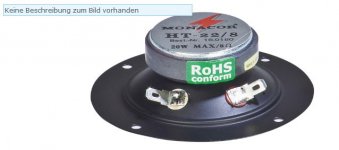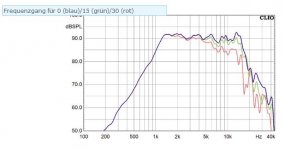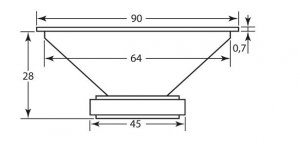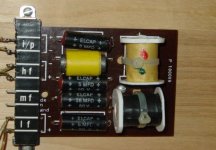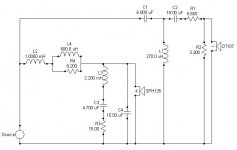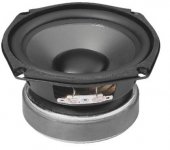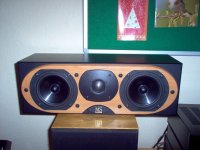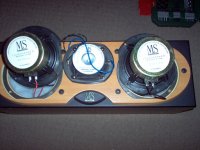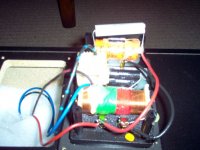I know it is a bit of a minority interest, but a few of us favour cone tweeters. I like the sound of full range units, and find that a cone tweeter is the best way to emulate this sound, and give the benefit of flexibility and treble extension. I have seen one or two threads on the subject of cone tweeters, but I can find no reference to the one I use; the Monacor HP-22. (with a Monacor 135 AD, in a 8 litre aperiodic box, with a 3.3uF cap.). I consider it to be a really good quality tweeter, that is ridiculously cheap (£4.38). But don't take my word for it, this is what Klang+ Tom say:
"The unit at the most favourable price was the surprise in the test......provides the most balanced frequency response in front of the microphone.....very attractive price, to be used without any problems, offers best measured values."
Has anyone else used these?
"The unit at the most favourable price was the surprise in the test......provides the most balanced frequency response in front of the microphone.....very attractive price, to be used without any problems, offers best measured values."
Has anyone else used these?
Sorry, my typing error; that should have been HT-22. Although it only goes up to 15k, it is very incisive. I am not made too aware of the missing 1/3rd octave.
I'd like to hear more about this Monacor polycone SPH 135/AD and HT-22 cone tweeter setup of yours on first order crosover, midrange, otherwise I wonder what you are saying here.
Robin Marshall: A Modicum of Genius Page 4 | Stereophile.com
I didn't really like what I saw with the Visaton TW-70 cone tweeter on single capacitor, but the 92mm monacor unit has a commendably better and flatter response and may open up more possibilities. So tell us more. I thank you. 😎
Atkinson: You say that you think a cone tweeter might be a better way of going about it?
Marshall: Yes I do. Because when a dome goes into breakup, it's utterly, totally finished. Uncontrollable. That's it. There's nothing more to be had. When a cone goes into breakup, all that's happening, providing you can control it, is that the radiating area is diminishing. It's much easier to control that. There's a lot of work to do, of course. I wouldn't like to say that you can just take a sheet of paper and design a cone tweeter which is going to be a world-beater. But I'm sure there's a lot of scope. I shouldn't say this, should I? I should just go out and do it.
Robin Marshall: A Modicum of Genius Page 4 | Stereophile.com
I didn't really like what I saw with the Visaton TW-70 cone tweeter on single capacitor, but the 92mm monacor unit has a commendably better and flatter response and may open up more possibilities. So tell us more. I thank you. 😎
Attachments
Hi Steve
Thanks for the link to that article, which I found fascinating. I use Mordaunt Short MS10 classics as my reference speakers, which have a huge Robin Marshall influence in their design (they are almost indistinguishable from Epos speakers)
My speakers started out based on the original Kef Coda in size and shape,( I had a pair of Kef T27s to play with). Wilmslow Audio recommend the Monacor SPH 135 AD as a replacement for the Kef B110, so I thought it would be dead easy. But T27 is much less efficient than the 135 AD. I have a very low powered amp, and rather than cut the output of the 135AD I looked for a tweeter of around 90dB output, and I had the HT-22s to hand and used them. I was startled at how good the combination sounded.
I have tweaked the design a lot and ended up with the following: The Coda box is 9'' wide and 6" deep (approx) and I use it against a rear wall, and angled in. This wide baffle and shallow box near a wall alleviates the baffle step problem. I have ended up with the 135AD running full range; (I would not claim that a proper xover would not be better). I tried various caps on the HT-22 and ended up with 3.3uF as my preferred value. The box has a sub baffle of 12mm mdf with a large oval cutout for the 2 drivers, and a baffle of 12mm plywood screwed to it with 10 screws. This makes toying with xover values and wadding much easier.
The "wadding" is fairly minimal. A thick layer of carpet on the back panel and on the bottom, nothing on the sides. (this is not panel damping). Then I have some weird tweaks; feel free to laugh, but they cost nothing. Between the drivers I have a horizontal strip of thin wood (card is ok for trying out) about 16cm long and 2cm wide about 0.5cm away from the baffle. I use a couple of blobs of blutak for this spcing. This seems to reduce the blur between the drivers. Then I have a piece of thin card about 4 cm deep and 9cm long vertically mounted at right angles to the frame of the HT-22 (no gap). This seems to give more presence. Both seem to improve stereo imaging.
Oh, the aperiodic loading is probably not that at all. But I tried drilling small holes near the corners of the baffle (where I reasoned the pressure was greatest) and tried blutaking various combinations closed and ended up with almost none; one 4mm hole (24mm deep) at a top corner and one 4mm hole at an opposite bottom corner. I felt that these gave a freer bass. I do cheat and have a REL Quake sub-woofer coming in at about 60 Hz (difficult to tell) for low bass.
Thanks for the link to that article, which I found fascinating. I use Mordaunt Short MS10 classics as my reference speakers, which have a huge Robin Marshall influence in their design (they are almost indistinguishable from Epos speakers)
My speakers started out based on the original Kef Coda in size and shape,( I had a pair of Kef T27s to play with). Wilmslow Audio recommend the Monacor SPH 135 AD as a replacement for the Kef B110, so I thought it would be dead easy. But T27 is much less efficient than the 135 AD. I have a very low powered amp, and rather than cut the output of the 135AD I looked for a tweeter of around 90dB output, and I had the HT-22s to hand and used them. I was startled at how good the combination sounded.
I have tweaked the design a lot and ended up with the following: The Coda box is 9'' wide and 6" deep (approx) and I use it against a rear wall, and angled in. This wide baffle and shallow box near a wall alleviates the baffle step problem. I have ended up with the 135AD running full range; (I would not claim that a proper xover would not be better). I tried various caps on the HT-22 and ended up with 3.3uF as my preferred value. The box has a sub baffle of 12mm mdf with a large oval cutout for the 2 drivers, and a baffle of 12mm plywood screwed to it with 10 screws. This makes toying with xover values and wadding much easier.
The "wadding" is fairly minimal. A thick layer of carpet on the back panel and on the bottom, nothing on the sides. (this is not panel damping). Then I have some weird tweaks; feel free to laugh, but they cost nothing. Between the drivers I have a horizontal strip of thin wood (card is ok for trying out) about 16cm long and 2cm wide about 0.5cm away from the baffle. I use a couple of blobs of blutak for this spcing. This seems to reduce the blur between the drivers. Then I have a piece of thin card about 4 cm deep and 9cm long vertically mounted at right angles to the frame of the HT-22 (no gap). This seems to give more presence. Both seem to improve stereo imaging.
Oh, the aperiodic loading is probably not that at all. But I tried drilling small holes near the corners of the baffle (where I reasoned the pressure was greatest) and tried blutaking various combinations closed and ended up with almost none; one 4mm hole (24mm deep) at a top corner and one 4mm hole at an opposite bottom corner. I felt that these gave a freer bass. I do cheat and have a REL Quake sub-woofer coming in at about 60 Hz (difficult to tell) for low bass.
I found some relevance in the Robin Marshall interview too. As well as Mordaunt Short, he also designed the Monitor Audio R252, which is the predecessor of my R300/MD speakers. Happens I've got some Mordaunt Short MS10i style 5" polycone woofers lying about awaiting inspiration too. 😀
We've had a thread going on LS3/5a mini monitor clones lately, and folks have been looking at the Monacor SPH-135/AD as a possible cheap driver. Problem is deciding on the bass notch required with a higher order filter. In fact 1.5kHz seems right according to THIS THREAD.
Monacor SPH135/AD Qts of 0.37 and Vas of 26L is saying 10L closed box to me, and bigger for aperiodic(damped reflex) and reflex. Certainly 5L is on the boomy smallish side for this driver.
What you have done is probably keep the impedance valve friendly with your minimal filtering and aperiodic box along with high efficiency as noted. All in all, very interesting, though I suspect the cone breakup from the bass unit would annoy me. I'd suspect you've got to know what is good about cone tweeters to appreciate them despite their poorer dispersion. It's going to be a lack of spit and sizzle compared to a soft dome. Perhaps less sibilance?
Include my usual heap of pictures of the 5" polycone Monacor bass unit and also some KEF Coda stuff complete with notch for the interested folks. 😎
We've had a thread going on LS3/5a mini monitor clones lately, and folks have been looking at the Monacor SPH-135/AD as a possible cheap driver. Problem is deciding on the bass notch required with a higher order filter. In fact 1.5kHz seems right according to THIS THREAD.
Monacor SPH135/AD Qts of 0.37 and Vas of 26L is saying 10L closed box to me, and bigger for aperiodic(damped reflex) and reflex. Certainly 5L is on the boomy smallish side for this driver.
What you have done is probably keep the impedance valve friendly with your minimal filtering and aperiodic box along with high efficiency as noted. All in all, very interesting, though I suspect the cone breakup from the bass unit would annoy me. I'd suspect you've got to know what is good about cone tweeters to appreciate them despite their poorer dispersion. It's going to be a lack of spit and sizzle compared to a soft dome. Perhaps less sibilance?
Include my usual heap of pictures of the 5" polycone Monacor bass unit and also some KEF Coda stuff complete with notch for the interested folks. 😎
Attachments
Although Monacor advise a 10 litre box for a closed box loading with their 135 AD, this is for an system Q of 0.7. Whilst this is theoretically ideal, very few designers use it for a speaker of this size. Somewhere between .8 and 1.0 is more normal.
Because the speaker is against a rear wall, I consider the "poorer" dispersion an advantage for my design.
Because the speaker is against a rear wall, I consider the "poorer" dispersion an advantage for my design.
Can I go off-topic for a moment and ask you if you know what the impedance of the bass unit in the MS10 was? Reason being the ones out of the MS821C centre speaker are 3.5 ohms nominal wired in series. Haven't measured the second order crossover coils yet, but it's fairly standard 3.2uF treble capacitor and 45uF bass capacitor which I think I can rejig for single drive units.
IIRC, the MS10i was a single coil bass tilt and 2.2uF tweeter filter capacitor with 50 ohm resistor shunted across the tweeter.
IIRC, the MS10i was a single coil bass tilt and 2.2uF tweeter filter capacitor with 50 ohm resistor shunted across the tweeter.
Attachments
Last edited:
i initally considered that monacor tweeter, when i was looking for a cheap modern cone tweeter. I ended up with the visaton FRS5X which im happy with. They cost £6, so also very cheap. The 'whoops' in the response of the monacor were a little problem for me, and at the time i thought it may have cone resonance issues. Maybe crackpot theory, but i didnt opt for them in the end. The FRS5X was also very cheap, and their response is flatter thru the most critical frequencies. System7, i believe you were interested in them too? Did you manage to buy any? The TW70 is also another worth trying (i havent, since i hoped to avoid a 3rd order network). I do wish i could find the motorola 3 inch piezo cone tweeters that Maplin used to stock, back in my youth. I reckon that now i know alot more about crossovers for piezos, that theyd be almost as good as youre likely to find. Great tweeters, at the time i lacked the knowhow to get the best from them.
Last edited:
The MS10i classic is rated as 8 ohm and the main drive unit just has a single coil in series with it which suggests to me a first order crossover and a 8 ohm drive unit.
I have just looked up the Visaton frs 5x, and they look really good, and being full range the crossover can be set as low as you want. Can you just mount them on the baffle, or should the rear radiation from the main driver be kept away from them? I had a different Visaton (frws 5sc) which from a frequency response and sensitivity point of view are not in the same league.
from my sims in boxsim with the frs5x, i used a sealed box of between 0.3 and 0.5 litre. Theyre 2 inch and quite high Qts so the hit xmax quickly used fullrange. Multiples on open baffle would work, but would be rather limited volume for a single. Id recommend closed box, or stuffed tube sub enclosure, and 2nd order, maybe 3rd order, at around 500hz minimum. Boxsim gives around 95 dB max output. Id suggest sealed volume or tube sub enclosure, and highpass at 500hz min 2nd order. If my sims with the audax woofers are of interest, i can post them. I did 2 circuits, crossed at 600hz and 4.5khz.
perhaps these screen shots would be at the least, a pointer to how you could use the FRS5X, if you wanted to 😀


Bearing in mind, that this is (kind of) optimised for the cabinet baffle size i designed for. Its still a work in progress, but its likely your baffle dims would be different to mine, and the response would turn out different also. But it gives you an idea.


Bearing in mind, that this is (kind of) optimised for the cabinet baffle size i designed for. Its still a work in progress, but its likely your baffle dims would be different to mine, and the response would turn out different also. But it gives you an idea.
- Status
- Not open for further replies.
- Home
- Loudspeakers
- Multi-Way
- Monacor HT-22
